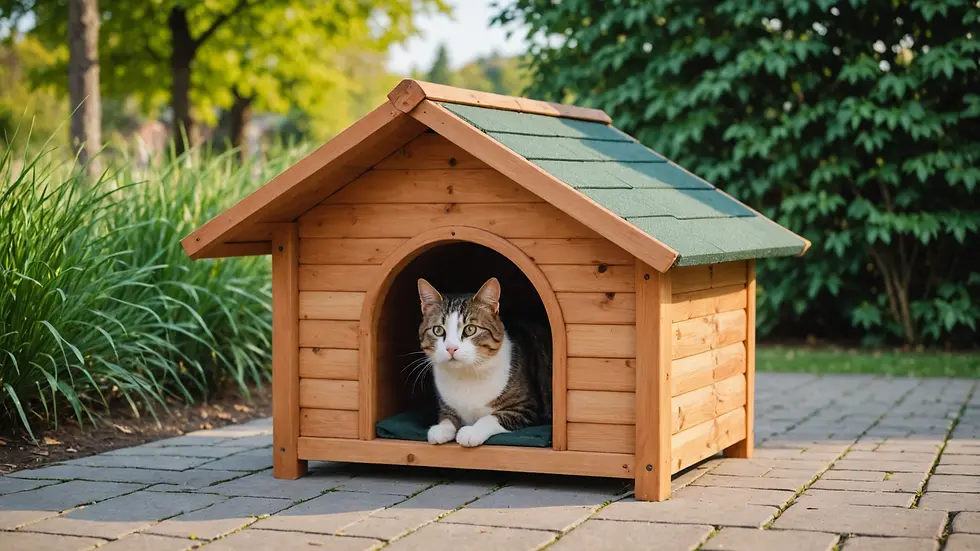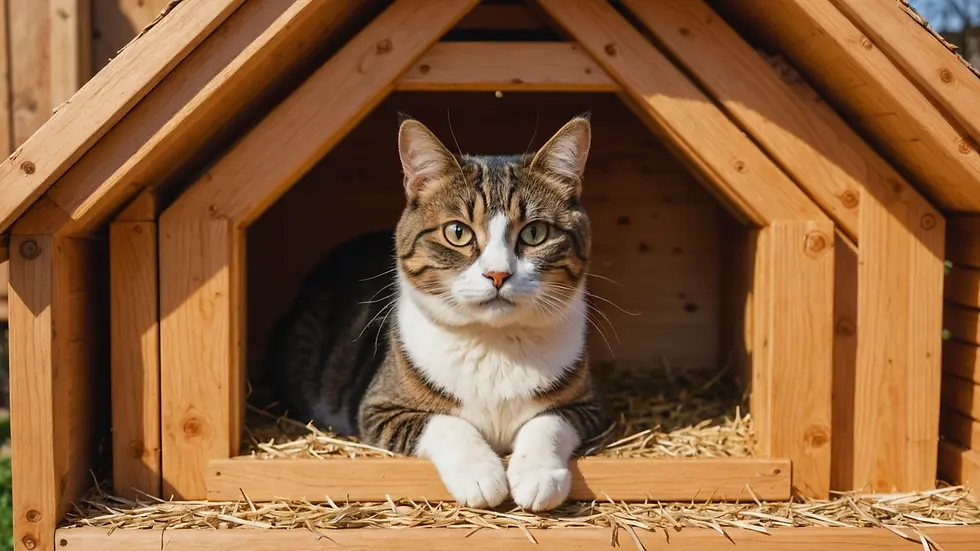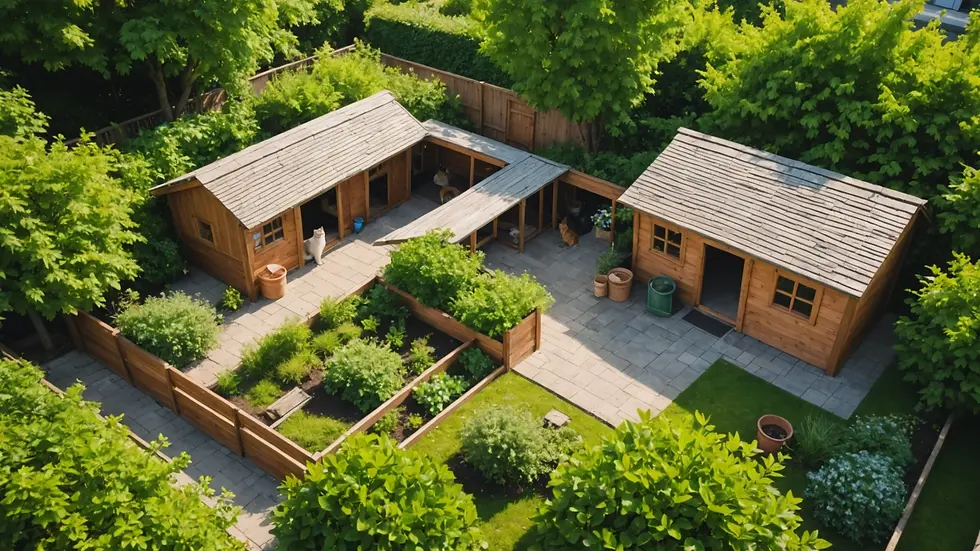How to Create an Outdoor Cat Shelter: Design Tips and Best Practices
- Jyotiraj Borah
- Feb 8
- 5 min read
Creating a suitable outdoor cat shelter can provide comfort and safety for community cats or your own feline friends. With an estimated 30 to 60 million stray cats living in the United States alone, the importance of these shelters cannot be overstated. An outdoor shelter offers protection against harsh weather conditions, predators, and disease, ensuring that our feline companions have a safe space to call home. This blog post outlines practical design tips and best practices to help you create a comfortable and effective outdoor cat shelter.
Understanding the Need for Outdoor Cat Shelters
Outdoor cat shelters are critical for protecting stray or feral cats from extreme weather conditions, predators, and diseases. According to a study by the ASPCA, unprotected outdoor cats face significant risks and have a lower life expectancy than those cared for indoors. A well-designed shelter provides a secure location where cats can find warmth, food, and protection from potential threats.
As more people become aware of the needs of community cats, the demand for high-quality shelters continues to grow. Many of these cats lack owners who can provide them with necessary resources, making it imperative for communities to take action by providing safe and comfortable shelters.
Choosing the Right Location
The success of your outdoor cat shelter largely depends on its location. Here are some key considerations:
Choose a sheltered area: Locate the shelter in a spot that provides protection from wind and rain, such as under a porch or in a wooded area.
Limit human activity: Areas with a lot of foot traffic can stress cats, making them less likely to use the shelter. Aim for quieter spots that offer some privacy.
Ensure easy access: The shelter should be easily accessible to cats at all times, especially during inclement weather when they may quickly seek refuge.
Selecting the right location significantly impacts the effectiveness of your shelter in supporting outdoor cats.
Basic Design Considerations
Size and Space
The shelter's size is crucial. Ideally, it should accommodate two or three cats comfortably while still maintaining warmth. A space measuring around 2 feet by 3 feet often works well, providing enough room for multiple cats to rest and sleep without losing heat.
Structure and Materials
Using durable materials is essential for your shelter's longevity. Here are some recommended options:
Wood: Untreated wood is a great alternative due to its durability and insulating properties. It provides a warm and inviting interior for cats.
Plastic: Heavy-duty plastic is a lightweight and waterproof option, making it suitable for outdoor use.
Metal: While metal is durable, it may not insulate well, causing extreme temperatures that can discomfort cats.
By ensuring that the structure can withstand outdoor elements, you create a cozy and safe haven for cats.
Insulation
Proper insulation is vital to maintain a stable temperature inside the shelter. Here are effective materials and designs:
Straw: Often recommended for insulation, straw retains little moisture and is cost-effective. It creates a warm, dry environment for cats, particularly in winter.
Double-walled designs: Creating an air pocket between walls can help moderate temperatures effectively, trapping warmth during cold weather and staying cooler in summer.
Entry and Exterior Design
The design of the entrance is crucial for safety and comfort:
Flap door: A flexible flap door keeps cats safe from larger animals while allowing easy entry and exit.
Height considerations: The entrance should be low enough for easy access but designed to keep larger animals out.
Slanted roofing: To prevent water accumulation, a slanted roof is ideal. Consider using waterproof coverings like tarps or thick plastic sheeting to protect against rain.
Paying attention to these design details ensures that your shelter remains functional year-round.

Ventilation and Safety
Ventilation
While insulation is key, ventilation is also essential in warmer months:
Airflow considerations: Including vents allows air to circulate while keeping out rain and wind, creating a comfortable cooling effect.
High openings: Place ventilation openings higher on the shelter to minimize drafts while allowing for adequate air movement.
Good ventilation helps maintain a healthy environment, preventing moisture buildup that can lead to health issues.
Predator Protection
Keeping cats safe from predators should be a top priority:
Secure construction: Use robust materials that cannot be easily breached by predators.
Elevated shelters: Raising the shelter off the ground adds extra protection from ground-dwelling threats like raccoons or coyotes.
Regular observations: Check the shelter and surrounding area frequently to assess safety and make necessary adjustments.
Taking these precautions can significantly enhance the shelter's safety for outdoor cats.
Weatherproofing Your Shelter
Consider the local climate when weatherproofing your outdoor cat shelter. Here are effective strategies:
Cold Weather Considerations
Insulation methods: Use straw or similar materials to prevent heat loss in cold temperatures.
Heating options: For areas experiencing freezing temperatures, a waterproof heating pad designed for outdoor animals can provide extra warmth.
Hot Weather Considerations
Natural shade: Position the shelter in areas that benefit from natural shade or create shade using tarps.
Cooling techniques: Install an effective ventilation system or utilize reflective materials for roofing to help reduce heat inside the shelter.
Effectively weatherproofing your shelter ensures that it provides safe refuge for cats in all seasons, helping them thrive in various conditions.
Maintenance Tips for Outdoor Cat Shelters
Regular maintenance is essential for prolonging the life of your outdoor cat shelter:
Routine inspections: Check the structure for damages or signs of wear every few weeks to address issues before they escalate.
Cleaning practices: Remove waste or leftover food regularly. Use biodegradable cleaning products to maintain a hygienic environment.
Restocking bedding: Ensure straw or bedding materials are clean and dry, replacing them as necessary to provide comfort and warmth.
Maintaining the shelter demonstrates your care for the cats and supports their health and well-being.
Building vs. Buying: Pros and Cons
Building Your Own Shelter
Creating your own shelter can be a fulfilling experience:
Customization: You can design the shelter to meet specific needs and preferences for the cats.
Cost-effective solution: Building your shelter can often be more budget-friendly than purchasing a commercial option.
However, this process requires time, materials, and some skills in construction.
Buying a Pre-Made Shelter
Convenience factor: Purchasing a shelter saves time and effort, especially for those with limited building experience.
Quality assurance: Many pre-made cat shelters are designed to provide optimal insulation and safety features.
On the downside, pre-made options can be costly, and they may not offer the level of customization you desire.
When deciding between building and buying, consider your budget, skills, and how specific you want the shelter to be.

Local Resources and Community Support
Connecting with local animal welfare organizations can provide valuable insights and support:
Community assistance: Many groups help with shelter construction by providing resources, expertise, and volunteers.
Fundraising opportunities: Local organizations often host fundraising drives to help support the construction of outdoor shelters.
You may also find workshops teaching shelter design principles that can enhance your project.
Final Thoughts
Designing an outdoor cat shelter is a meaningful endeavor that significantly enhances the welfare of outdoor cats. By applying the tips and best practices discussed in this guide, you can create a secure and comfortable environment that addresses the needs of these animals.
Remember, an effective shelter should prioritize insulation, safety, and maintenance to ensure it serves its purpose throughout the year. With careful planning and consideration, you can positively contribute to the lives of community or pet cats, making a lasting impact in your area.





Comments